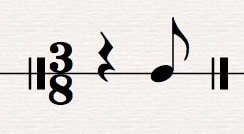
Are you getting saucy looks from band mates every time you play a solo break? Or do you have that horrible floating sensation when your solos go awry? Do you lose track of where the beat is?
Well, worry not! for here is a little metronome-based exercise that can help you with your rhythmic accuracy, and time feel.
Now, A Word of Warning: Some people view exercises with metronomes as cold and unmusical.
And I’d agree.
Just like scales, arpeggios, intervals, strings and cables are unmusical. They’re just things that might help you make some music. Just like brushes and paint are to a painter. So take a deep breath, CHILLAX, and try this…
The Big Idea
So the usual way of using a metronome is to have it click on every beat. If you’re a bit more advanced, maybe you’ve tried placing the click on beats 1 and 3, or beats 2 and 4. This means that the metronome is generating the beat, and you have to align your time to it.
I want to sell you on the idea of placing the click on a subdivision of the beat.
This means that YOU have to generate the beat. Practising this way means you’re working on your time and making it stronger.
Here’s how you can apply the idea to practice a triplet feel.
Rhythmic Accuracy Exercise #1
Avoiding placing the click on beat one leaves you two places to put the click: The 2nd or 3rd quavers.
So, In one bar of 3/8 that’d be here:

or here:

In simpler terms. If you count each beat like this: 123, 123, 123, 123. You just put the click on the 2 (as in the 1st example) or 3 (as in the second example).
Hearing The Click
If you’ve not done this before it’s a bit tricky to feel the click in the right place. You might be drawn to hearing the click as a downbeat all the time. So to put the click on the last triplet, do this:
Start the click at 60 bpm and count three even quavers in the space of one click. (123, 123, etc)
That’s the rate at which the quavers sound.
Now hear the click as the last quaver and put your downbeat on the next quaver. Feel it as going ‘and, one’ with the ‘and’ co-inciding with the metronome click. You can even trick yourself into hearing this by calling the click ‘3’, and saying ‘312, 312’, etc, and then mentally shifting your beat to the 1.

Got it?
Now play a repeated dotted crotchet on the beat [you’re playing on the downbeat while the metronome is clicking on the 3rd quaver]
Keep it steady.
Good?
Try playing a scale.
Still good?
You have to feel where the pulse should be to keep feeling the metronome click as the last quaver. Continue to do this until you can keep the beat and you don’t switch the metronome around so that you’re playing with the clicks.
Rhythmic Variations
Practise all the variations below to improve your rhythmic accuracy. Where you have a long note you can either play it for its full duration or play it as a quaver; do it both ways. [the top line shows the rhythms to practise; the bottom line is where the metronome click is]

Now improvise. Stay within the triplet feel, always focusing on keeping the beat rock-solid and making sure everything sits exactly in that feel. If you lose awareness of the beat for a second you’ll rush or drag and the click will immediately feel different. It might shift to a straight 8th feel; or, you’ll shift by a quaver and the click will be on the beat.
Accuracy & Concentration
So to do this requires accuracy of how you feel the pulse & subdivisions, as well as having your technique be pin-point and not rushing or dragging. Also you’ll need to maintain your focus. And these things require time. Go easy on yourself!
I’d suggest trying this for 5 minutes every day. View it like trying to get better at ice-skating – the first time you have a go it’s very unlikely you’ll be able to stay on your feet. Stick with it, and soon you’ll start to feel more relaxed and sure of your time.
Other things to try
- Put the click on the second quaver.
- Use 6/8. Now there are 4 places you can place the click [excluding the easier 1st and 4th quavers] Also, you could have the metronome click twice in one bar by using the 3rd quaver of beats one and two.
- Use 9/8
- Use 12/8
- Use an odd-time feel e.g, 7/8 and practice with the click in all locations.
- Use a different beat subdivision. E.g., semiquavers. Use the less familiar 2nd and 4th semiquavers and their locations with whatever bar length you use.
- Try using an odd grouping as the beat subdivision. E.g., play in 4/4 but using groups of 5 as the beat subdivision and place the metronome click on one of these subdivisions.
More Abstract Ideas
Here are some more ideas that you’re going to have to have a think about. Play around with them and see what you come up with.
- Play in time but free pulse – like you’re improvising bar-lines. I think whenever I play in situations where I have to play free music, I focus most on melody and hearing the harmony. But I’m also at liberty to be free with rhythm.
- Rhythms like triplets, semiquavers and so on are regular demarcations of time, but there is no gradation of time; the measurement is a construct. Within the limit of a particular rhythm there might be pushes and pulls that cause it to feel or sound a certain way. Also, is it possible to play stuff over the time but have it take its own time. I’ve played in some groups where we’ll have a groove going on in the drums and the rest of the band float over this in their own time. Also, playing certain kinds of pieces, the phrase you’re playing can unfold in its own time. So, combining these ideas, another thing to try is playing in a groove but allowing phrases to have their own rhythmic independence from the groove.
Right, time for biscuits… Feel free to share any rhythmic related ideas/thoughts/gibberish below or perhaps share your favourite rhythmically interesting music. Why do you like it? What is going on?
If this seems too hard and you still want to get a smokin’ time feel, all you really have to do is jam along to records and pay close attention to making what you do feel just like what they do.
Until the next time!
-Mike
PS – If you want to hear these examples and go further into rhythmic study, you need to check out ElectricCampfire.com. I’ve got some great actionable lessons that’ll show you exactly how to do this kind of thing and more.
Good stuff Mike and quite timely for me. I guess some of this, esp. the first exercises you mention would help with swing feel to some degree? I know my own swing feel ‘squares off’ all too easily. Do you have any specific exercises/suggestions for swing feel practice?
Ade x
…er that link off my name should be too http://www.myspace.com/adestevenson
Hey Ade, thanks for your comment. Yes, this is a good exercise for that feel. Maybe play a tune that has lots of quavers in it but no semis like Scapple or Donna Lee [make the first turn thing into a triplet] and do it slow. I try to look for places to pick on the up-beat and slur onto the down-beat too.
Hi Mike, cheers for that. Funnily enough I was only looking at videos for improving my timekeeping yesterday. Check out this one below featuring Victor Wooten – great stuff and along a similar vein to your exercises here.
https://www.youtube.com/watch?v=9X1fhVLVF_4
Take it easy
Hi Arron. Thanks for that link; that’s a fantastic video! Victor is a beast, eh? Love his playing. I have his bass video but am delaying putting it on to delay the pain :)
Great lessons Mike, really appreciate having hem as a resource, esp at the moments as funds are a little tight for regular lessons. Is there any way of getting them in a nice printer-friendly format though? Would help with working through the ideas you’ve laid out – copy and paste misses the notation. Keep it up, and many thanks for sharing your knowledge and tips.
Hi Sara, glad they’re of use. Yes, a printer friendly version is a good idea. I’ll investigate how to do it, shouldn’t be too hard. One thing that usually works is to press print and then ‘save as PDF’ then just save the pages you need. That’s a faff though, so I’ll figure out a solution. Thanks for checking it out! M
No worries, I’m glad I found it! I’m focussing on learning jazz at the moment, so both the rhythm and scale tips are just perfect for what I need to work on. I posted in the reviews bit of the guitarnoise.com forums to share your wealth (I should be a politician with skills like that…), hope it adds to the traffic your site gets.
Thanks a lot for the mention on the guitarnoise site. You’re a star. Got some good phrasing stuff coming soon but it’s way too long at the moment. Re: the printing thing, I’m thinking the easiest thing would be to put all the notation on a PDF, so off to do that now. Cheers! M
Hey Sara, sorted it now with a WordPress plugin. Check out the bottom of the blog post and you’ll see the ‘Print Friendly’ icon. Click that, and you’ll be able to print and edit a version of the page to your liking.
Hope it works, let me know. M
Thanks for a great site, Mike!
Suggestion:
A group of three quavers played in duration of a quarter-note can be called “a triplet”, and any one of the notes in that “triplet” could be called………..”a triplette”.
So with the metronome, we can put the beat click on, say, “the second triplette”.
I would put the stress of “triplette” on the second syllable.
You guessed! I should get out more…….I know!